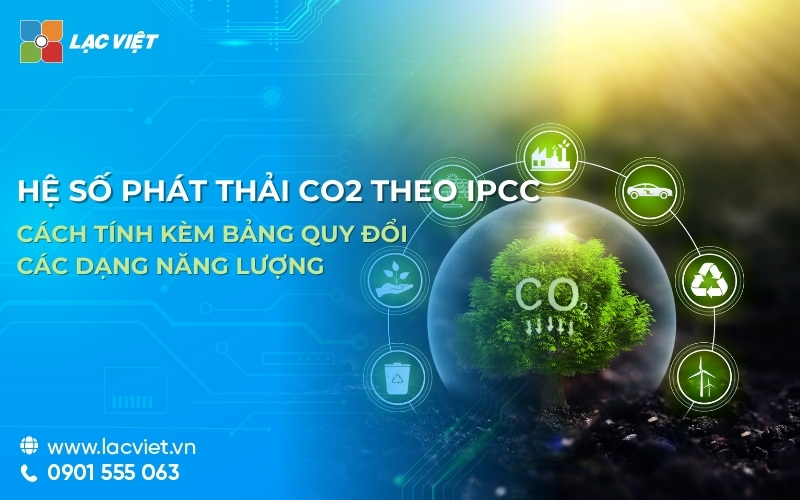Coefficient of CO2 emissions has become an important factor for businesses and organizations on the transition to green and reduce greenhouse gas emissions. This article Lac Viet Computing will provide detailed information on coefficient of CO2 emissions according to the IPCC to help businesses understand how to apply, in compliance with the international standards of credits carbon.
1. Coefficient of CO2 emissions according to the IPCC is what?
Coefficient of CO2 emissions be understood as a quantity denoting the amount of CO2 arising in the process of using fuel or specific activities. This is important tool to measure and report greenhouse gas emissions.
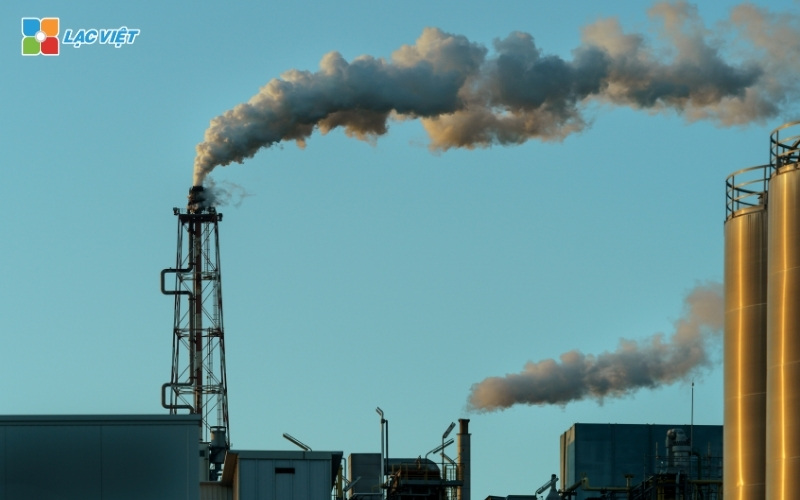
Coefficient of CO2 emissions based on global scientific reason The intergovernmental panel on Climate change (IPCC) development.
Introduction to the IPCC:
- Founded in 1988 by the united Nations, the IPCC is an organization providing a comprehensive assessment of climate change and response solution.
- IPCC synthesis and analysis of scientific data from hundreds of countries to develop emission factors appropriate to each industry and geographic area.
Advantages of the method of the IPCC:
- Precision: coefficient of emission is frequently updated based on new scientific study most.
- The ability to widely applicable: Suitable for many industries and scale the organization, from small businesses to large corporations.
The role of CO2 emissions:
- Assess the environmental impact of the activities of production and operating.
- Provides data standardized to report and inventory of greenhouse gas according to international standards such as the GHG Protocol or ISO 14064.
- Scope 3 Emission is? Comprehensive guide to measuring and managing emissions indirect
- CBAM is what? What should prepare to cope with adjustment mechanisms border carbon of the EU?
- What is CO2 offset Point? Explained in easy to understand and practical applications for business
- Carbon Neutral is what? Roadmap to help businesses achieve carbon neutral
2. How to calculate the amount of co2 emissions according to the IPCC
2.1 calculation formula
The emission = the CO2 generated X Amount of fuel or activities used
In which:
- The CO2 generated: Measured in kilograms (kg) or tonnes (t) CO2.
- The amount of fuel or activities used: Usually measured by the Gigajoule (GJ), kWh, energy, or fuel.
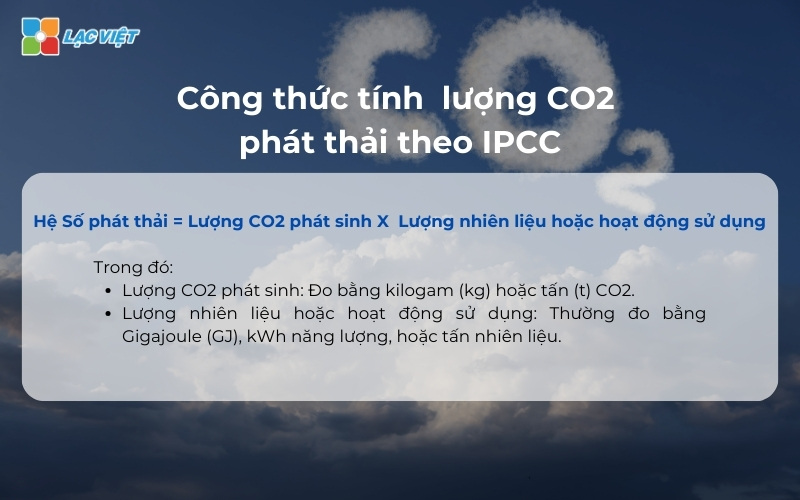
2.2 the construction IPCC emission factors
- Data source: Emission factors were developed based on data on fuel, industrial production, technology use in different areas.
- Classification of fuel: The IPCC provides the emission details for each type of fuel, such as natural gas, diesel oil, coal, or renewable energy.
- Reviews the life cycle (LCA): The emission not only calculate the amount of CO2 emitted during use, which also includes all the stages of extraction, transportation, processing fuel.
2.3 conversion coefficient of the form of energy common
Below is the conversion table in the form of energy common to TOE (Tons of Oil Equivalent):
| Type Of Energy | Unit | TOE/Unit | Calorific Value (MJ/Unit) | The coefficient Of Emission of CO₂ (kg CO₂/MJ) | Emissions CO₂ (tons CO₂/Unit) |
| Power | 1.000 kWh | 0,1543 | – | – | 0,6766 |
| Coke | 1 ton | 0,70 – 0,75 | 29.309 – 31.402,5 | 0,0946 | 2,77 – 2,97 |
| Coal type 1,2 | 1 ton | 0,70 | 29.309 | 0,0983 | 2,88 |
| Coal type 3,4 | 1 ton | 0,60 | 25.122 | 0,0983 | 2,47 |
| Coal type 5,6 | 1 ton | 0,50 | 20.935 | 0,0983 | 2,06 |
| DO oil (Diesel Oil) | 1 ton | 1,02 | 42.707,4 | 0,0741 | 3,165 |
| 1,000 liters | 0,88 | 36.845,6 | 0,0741 | 2,730 | |
| Oil FO (Fuel Oil) | 1 ton | 0,99 | 41.451,3 | 0,0774 | 3,208 |
| 1,000 liters | 0,94 | 39.357,8 | 0,0774 | 3,046 | |
| LPG (liquefied petroleum Gas) | 1 ton | 1,09 | 45.638,3 | 0,0631 | 2,880 |
| Natural gas (Natural Gas) | 1,000 m3 | 0,90 | 37.683,0 | 0,0561 | 2,114 |
| Gasoline cars – motorcycles | 1 ton | 1,05 | 43.963,5 | 0,0693 | 3,047 |
| 1,000 liters | 0,83 | 34.752,1 | 0,0693 | 2,408 | |
| Jet fuel | 1 ton | 1,05 | 43.963,5 | 0,0715 | 3,143 |
| Rice husk/biomass solid other | 1 ton | – | 16.100 | 0,100 | – |
| Wood/Wood waste products | 1 ton | – | 16.200 | 0,112 | – |
*Note: The coefficients TOE/unit is reference from the office of 3505/BCT-SCIENCE AND TECHNOLOGY date 19/04/2011. Temperature coefficient value (MJ/unit) and coefficient of emission of CO₂ is calculated based on the conversion value of 1 TOE = 41.870 MJ according to the IPCC.
The conversion of energy forms on the TOE to help standardize easily compare the energy consumption between the different types of fuel, to support businesses in managing energy efficiency, comply with standards on greenhouse gas emissions.
3. The factors affecting the emission
Coefficient of CO2 emissions can vary depending on the following factors:
- Type of fuel used:
- Fossil fuels such as coal and oil, the diesel engine has the emission higher than natural gas or renewable fuels.
- For example, natural Gas has the emission of about 56 kg CO2/GJ, while coal amounted to 88-100 kg CO2/GJ.
- Manufacturing process or operation:
- The manufacturing process is modern and energy-efficient help to significantly reduce emissions.
- For example: A power plant technology using coal-fired supercritical would be less emissions than power plants traditional.
- Geographical conditions and specifications: Different areas use fuel with chemical composition and different process, affect the amount of CO2 arise.
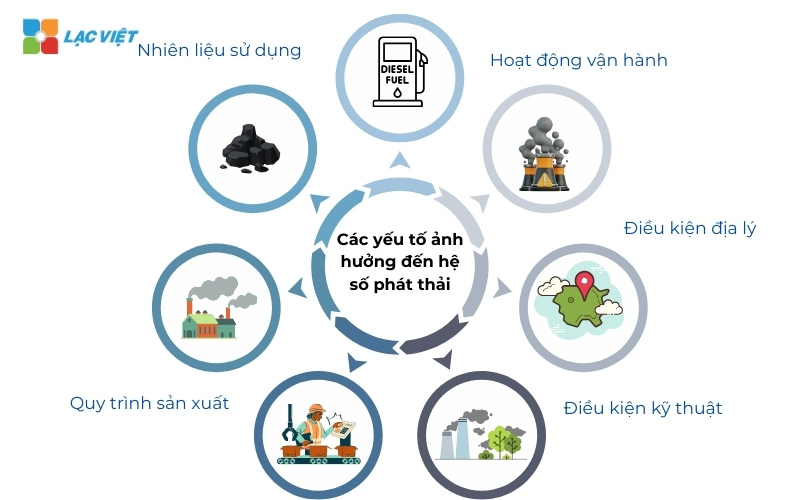
Illustrative example
- Natural gas: With the coefficient of the average emissions 56 kg CO2/GJnatural gas is considered as options less emissions than out of the fossil fuel.
- Coal: The emission from 88-100 kg CO2/GJdepending on the type of coal used (coal or brown coal).
- Diesel oil: The emission of about 74 kg CO2/GJhigher than natural gas, but lower than coal.
- Renewable energy: The emission is almost equal to 0, except for the emissions indirectly from manufacturing and shipping.
4. App coefficient of CO2 emissions according to the IPCC in practice
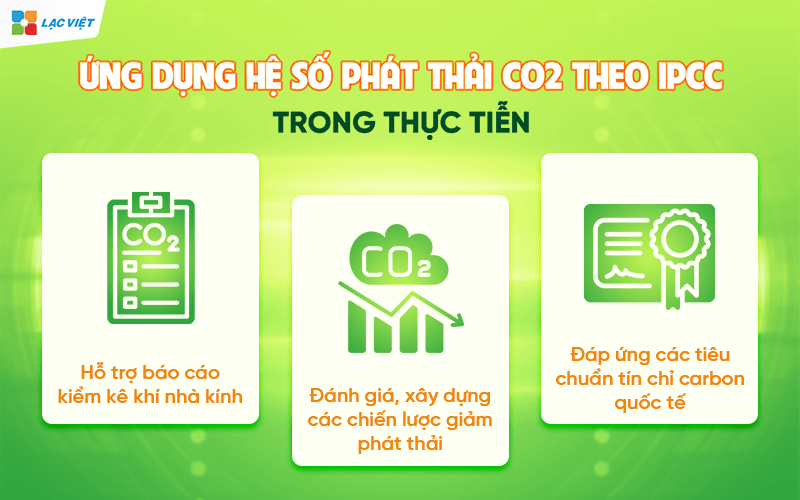
4.1. Support report greenhouse gas inventory
Coefficient of CO2 emissions according to the IPCC is important tool for business to make the report emissions and greenhouse gas inventory:
- Compliance with international standards: GHG Protocol and ISO 14064 standards and other requirements detailed report about the amount of CO2 emissions from production activities, operating.
- Increase transparency: Help the organization provide transparent information about the amount of CO2 emissions for stakeholders such as investors, customers, regulatory authorities.
4.2. Build strategy to reduce emissions
Businesses can use the coefficient of CO2 emissions to assess and build strategies to reduce emissions efficiency:
- Assess the impact of the supply chain: Analysis of the emission source, the largest in the supply chain to optimize or replace with sustainable solutions.
- Optimized production process: Apply clean technology, improved manufacturing processes to reduce the amount of fuel consumption and CO2 emissions.
4.3. Compliance with the standards credits carbon international
Coefficient of CO2 emissions according to IPCC enterprise support to meet the requirements of the credit system carbon:
- Market participants trading emissions: For example: System Trading emissions of the European union (EU ETS) requires businesses to accurately calculate the amount of CO2 emissions to buy or sell credits carbon.
- Promote sustainable business: Use the emission to design strategies to reduce emissions not only regulatory compliance but also enhance the brand image and competitiveness in the international market.
5. Benefits of using the coefficient of CO2 emissions according to the IPCC
5.1. For business
The application of the coefficient of CO2 emissions according to the IPCC brings many practical benefits, help businesses improve operational efficiency and achieve sustainable goals:
Reduce operating costs:
- Optimized use of energy thanks to the accurate measurement and analysis of the source emission largest.
- Reduce consumption of energy and fuel, thereby saving the cost of production.
- For example: A manufacturing enterprise cement applied emission factors to reduce the amount of fossil fuel, save 10% on energy costs annually.
Increased access to international markets:
- Compliance with the standards credits carbon to help businesses easily participate in market transactions, the international emissions as the EU ETS, or CORSIA.
- Build brand image, green, attract investors and customers preferred products friendly with environment.
5.2. For social
Coefficient of CO2 emissions is not only beneficial for business but also contribute positively to the society:
Mitigate climate change:
- The reduction of CO2 emissions directly help to limit the global warming.
- Support the government achieve its goal of reducing emissions in the framework agreement Paris climate change.
Promote clean technology and sustainable energy:
- Encourage investment in renewable energy technology, energy efficiency and the solution produces less carbon.
- For example: The use of emission factors have driven the major industry investment in wind energy and solar.
6. The enterprise deployment pressure of CO2 emissions like?

Step 1: build measurement systems for emissions reporting
- Set system of measurement: Identify the sources of emissions in the production chain, from raw material input to products output.
- Collect and analyze data: Based on the calculation formula standard of the IPCC, enterprises need to deploy the measuring equipment, such as CO2 sensor or use reports from the fuel supplier.
- Construction emissions reporting: In compliance with the international standards such as the GHG Protocol or ISO 14064 to ensure transparency and accuracy.
Step 2: Use software management system emissions
- Software tools to help automate the calculation and tracking emissions. For example: Using specialized software, such as the Carbon Trust Footprinting to data management, and reporting.
- Reviews effectively reduce emissions from the project improvements or changes in fuel sources.
Step 3: Integration of the emission on operational processes
- Put the index of the emission of CO2 into the decision-making process choosing a provider, or technology based on low emissions.
- Apply solution, green production, improved equipment to reduce emissions.
Step 4: track and periodically updates the data emissions
- Continuous tracking: Use the measurement system or automatic test periodically to ensure data emission accurate.
- Update data: Updated emission factors according to the latest report of the IPCC to properly reflect reality.
- Evaluation and improvement: Use the data to assess the effectiveness of measures to reduce emissions, thereby implementing the new strategy.
7. Frequently asked questions (FAQs)
7.1. Coefficient of CO2 emissions have changed over time?
- Answer: Yes. The emission of CO2 can be changed according to the new scientific research and data practices updates. The IPCC regularly publish new reports with the emission be adjusted based on technology, fuel sources and environmental conditions present.
7.2. How to calculate the coefficient of emissions for manufacturing industry specifically?
- Answer: Businesses can use basic recipe:
The emission = {the CO2 generated}X{Amount of fuel or activities used} and refer to the standard coefficient by the IPCC to offer. In addition, the use of management software, emissions or advice from the expert environment also helps with more accurate calculations.
7.3. Small and medium enterprises have to apply the coefficient of CO2 emissions according to the IPCC not?
- Answer: Yes. Whether it is large or small business, the applicable coefficient of CO2 emissions not only help meet the legal standard but also optimizing operating costs, improve competitiveness and create conditions for participation in the international market.
Coefficient of CO2 emissions according to the IPCC is an important tool to help organizations and businesses do not only measure but also reduce the impact of greenhouse gases on the environment. The use of the emission ensures that the activities of production and operating properly implemented according to international standards, forming the basis for achieving credits carbon and sustainable development.

